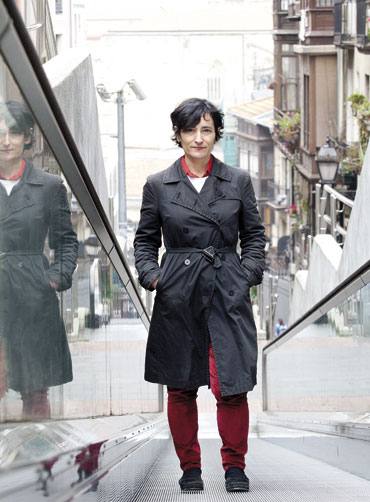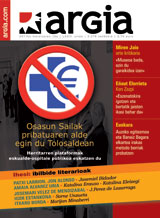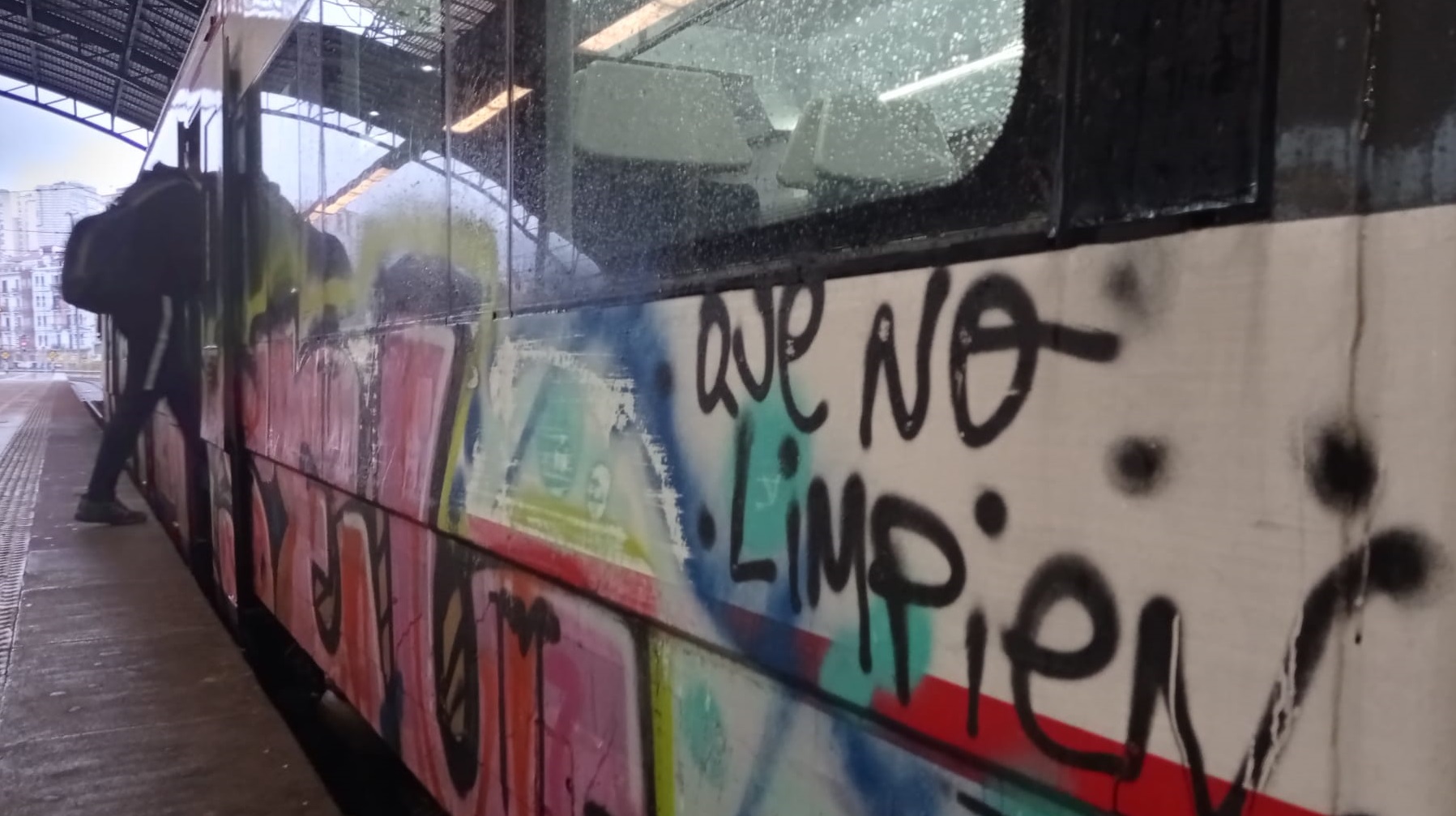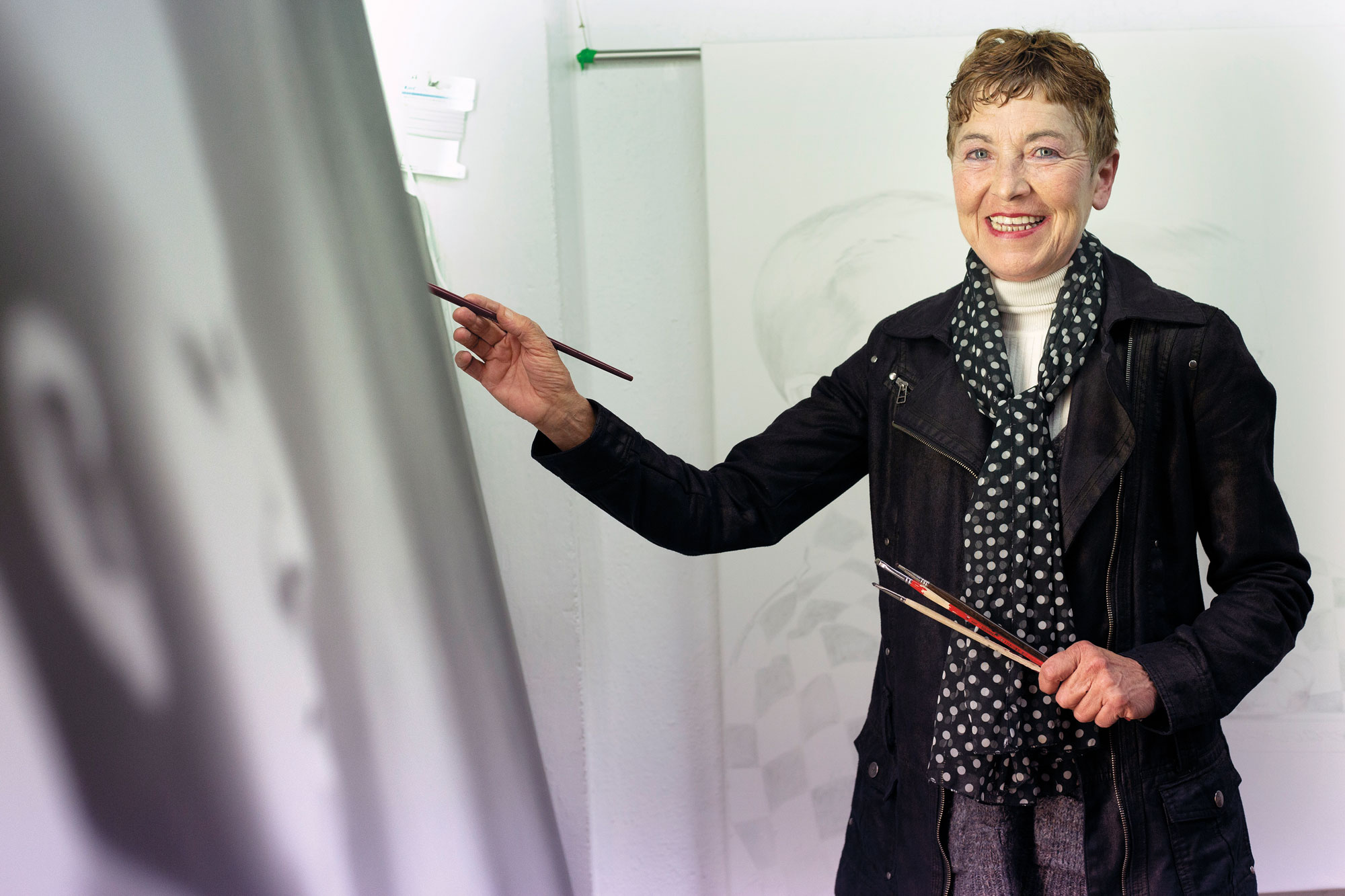- There is no such thing as the saying “we are because we were”. Here it is necessary to ignore what the previous ones have done, interrupt the existing thread, invent where or where to create another, and do it. It's contemporary art.

The day I spoke to you, the news in the newspaper, the Bonnat Museum in Bayonne will be closed for three years. A few weeks ago, Chillida Gune was closed. Later, the new San Telmo was inaugurated. The Guggenheim is always there. Just like Artium. Like Jorge Oteiza from Alcieza... Fine Art Museums... What is this museum noise?
You're talking about museum noise, and it's true that over the last two decades, that of contemporary art museums has become a noisy phenomenon. In any case, this has been a global phenomenon, although here, due to the opening of the Guggenheim Museum in Berlin, it has more resonance and a more special meaning. A global phenomenon, I say, because the same cultural policy has been carried out in all parts of the world, that is, contemporary art centres and museums have been opened in an almost obsessive way. What do we say about what we have now? Well, we planted it, and now we're harvesting... The economic crisis has highlighted the contradictions of these cultural policy bets. We have the current crisis of the economic model based on growth, of which the art system is also part. Over the past 15 years, cultural facilities have proliferated, creating imbalances, and it is only natural that this unequal cultural system, as in all other areas of the economy, is also in crisis. And cuts in the economy, and cuts in art, cultural equipment and museums. But the roots of that “museum noise” that you say are deeper and already come. For four decades now, the theorist Fredric Jameson has been identifying the capitalist consumer society we have, advanced capitalism or the symbol of post-Ford society, and he called this society a “cultural explosion”. As we know, the philosophical movement that will give ideological justification to this social model is postmodernity. And the main feature of this movement will be the loss of historical sense.
You said “cultural explosion”...
Yes, it means that there is nothing that escapes the cultural sphere, because anything is a cultural phenomenon: both to go to see exhibitions, but also to walk from bottle to bottle or from bar to bar. Everything we do is culture, as everything we do is an act of consumption. This process already comes with the birth of the mass consumer society during the 20th century and the development of the cultural industries on which it is based, i.e. the film industry, the phonographic industry, etc. In short, this “cultural explosion” means precisely this, that advanced capitalism – where consumption is central – is the key category of “culture” to study and understand. Underneath it is clear what is there: that art is not, as the avant-garde wanted it to be, it will be autonomous, it will depend on the market.
However, we still do not answer the main question: why do culture and art have their importance? Well, because they have that intangible thing that we all want, the symbolic value or, according to Guattari, the “surplus of power”. This implies the instrumentalization of art and culture. We know that historically art has been at the service of ideological powers since the time we lived in the cave. But within the organization of this advanced capitalism, we will see clearly how culture, and art, will be subordinated to economic – and political – power. According to George Yudic, cultural policies will begin to use art and culture as “resources.”
Speaking of contemporary art, museums and more... Are all contemporary art museums meant to fit in the same sack?
To answer this question we will first have to clarify what a museum of contemporary art is. A museum like this is an institution that makes a historical reading of the present, the past and the future through works of art. And if it is a historical reading, it must necessarily be critical. What makes a museum of contemporary art critical?... On the one hand, it is clear that the reading generated by the collected works of art is responsible for this criticality. But not only are museums full of political art necessarily critical? No, not necessarily. Museums are not empty containers, they have to show criticality, not only in their contents – that is, in the works of art collected – but also in their forms of elaboration, whether oriented to the exterior or to the interior... I am saying that the museum must be critical, especially at a time when there is talk of a loss of historical sense. However, the museum is not the only art institution in the art world.
What do you mean?
From the university to the galleries, there are many elements and institutions in this production chain: from the formation of the artist who wants to be an artist to the suspension in his house where the work is collected, there is a great path. Arteleku was an example... It was founded during the time when Imanol Murua was a deputy, in 1986. Murua founded Arteleku following the advice of Nestor Basterretxea. I would say that even at that time they had an awareness of the symbolic value of art, but not so much of the ways in which this symbolic value is capitalized economically or politically. “Close the artists at the expense of the euro!” was the slogan, and in twenty years Arteleku had a certain freedom to make art, and to study ways of making art...
What do Contemporary Arts and Cultural Policy have to do with it?
Politics has always been there. However, with the sense we understand today, they began to take effect in the early decades of the 20th century. This is where we will have the case of the Soviet Union, where avant-garde artists put their work at the service of the political project. There we have Rodchenko, Stepanova, etc. Or the United States, after the crash. The program, created by President Roosevelt, launched a project to promote art and artists—the Federal Art Project—or to combat poverty through art. These are the reports of Dorothea Lange, Walker Evans and many other photographers who portray the misery of Oklahoma and the central states of the United States. The target? To democratize art and culture, to give opportunity to all people, to socialize the art that until then was available to the rich and elites. Since then things have changed a lot. I find it quite revealing that in the same year, 1982, two texts appear together. On the one hand, the first consensual definition of “cultural policy” drawn up by UNESCO and, on the other, Guattari’s talk entitled “Culture, a reactionary concept”. What the avant-garde hitherto considered a revolutionary concept, Guattari claimed to be reactionary, quite the opposite! As I said before, according to Guattari, art has an added value of power, we all want to amortize it, make it profitable and take it from us. Cultural politicians will soon discover this surplus of power and immediately begin to exploit art and culture. It is up to policy makers to design cultural policies, and this is how it should be. It is advisable, however, to have the appropriate art consultants, as Murua did, and not to consult the adjoining publicist. Unfortunately, this is often not the case. Politicians prioritize short-term political performance, which is not good... We don’t realize the imbalance that giant ghosts create in the art system.
Has the Guggenheim unbalanced the system?
More than him, his shadows. It had a huge media impact. The cultural explosion of the 1990s, among other things, led to a new cultural paradigm that extended to urban models, where contemporary art had its place. The most obvious example is the Guggenheim effect. Well, we say “Guggenheim effect” in our country, but abroad, you have “Bilbao effect”... As I have read it now, the people of Margate in England – a Zarautz without glamour – seem to want to copy the Guggenheim effect! Therefore, not only in our country, but also abroad, the museums of Contemporary Art have opened one after the other, Guggenheim has had a multiplier effect and has brought monoculture, but there are many facilities in art other than the museums that maintain their balance.
At home we are not passionate about museums, but we have already seen the Museum of Fine Art and Artium in Vitoria-Gasteiz and the Guggenheim and Fine Art in Bilbao. We saw people at the museum. In Vitoria-Gasteiz, no one but us... Every city wants a museum. Is that a waste of money?
The Basque Country is small and it is true that due to the overlapping of political institutions – municipalities, deputies, the Basque Government – in our country three different cultural policies have been superimposed, often without any dialogue or coordination between them. This has created a repetition and mimesis of the equipment. In us, and in many other places. The opening of museums in one city and another, without studying the needs of each one, is not good. In our country, everyone has their own cultural equipment in mind, often without taking into account those of others, which has led to very similar equipment, without thinking about our dimensions and needs... The Guggenheim effect has tried to copy in many places, inside and outside of us, but it has only had a real impact in Bilbao, because the surprise only works once. I don’t know what the solution will be. Sitting all around a table would help a lot: dialogue, talking to each other, each one raising their own priorities and problems... As a small town, I think it’s easy for everyone to sit around a table. The will to do so is required.
A question that the audience often asks? “And that, is it art?”, looking at the white painting with a blue-blue stripe in the center...
The compensation for this cliché or common place is another cliché: “Any artwork that is commercial cannot be of quality.” The origin of the two clichés comes from a certain tension or unresolved antinomy that the historical avant-gardes put on the table: the utopian avant-garde implied in itself the promise that the new art must be for everyone, that is, the democratization of art, but at the same time, for art to be a true art – new art, dissatisfied, experimental, critical of what exists, revolting – it must be autonomous, as a result of which it is condemned to be misunderstood and misunderstood. After the historical avant-garde, the positions went to extremes: Alexandrian positions –elitists–, populist positions that look at art with mistrust – “Look, there’s one thing I don’t understand. It's made for me to enjoy, but I don't understand. They treat me like a fool.” Art is a specific framework for knowledge and experimentation, just as genetic engineering is a specific framework for knowledge and experimentation. Their language and codes are very specific. Those of us who work in the field of art must make great efforts to expand our knowledge of art and to listen as little as possible to this question: “Is that art?” There the education departments of museums and similar centres do a good job. The more you know about one thing, the more you enjoy it. But this tension will always be there, and it will last for many years, otherwise we would not have art, otherwise we would go to Corte Inglés or Max Center to find and buy art. And no one wants that, right?
Museums museums, what do you think are the main challenges or challenges facing art today?
I’m not going to start as a politician, saying how times of crisis are times of opportunity, etc. However, I think what has come to us is healthy. I have a lot of friends who are artists and they are having a hard time, they sell less jobs, they have had an uncertain life so far and worse now... They have decided to be artists, that is the bet on the euro and they are trying to keep it. Regardless of their situation, I think this is an interesting moment: many of the interests that have been left over in the art world will disappear, and it will be because only those who continue to work in art are interested in art. Art will lose its glamour because it won’t move that much money. Institutions may go to extremes. Some will prioritize visibility in programming, implement more populist policies. At the other extreme, more committed bets will be made and greater efforts will be made to make art.
What is the “Darwin Nightmare”? You mentioned it more than once here and there...
It's a movie. It uses the situation of Lake Victoria in Tanzania to show the damage that globalization has done. It tells how the Nile Perch, a non-native large fish, was introduced into the lake and broke the lake's ecosystem by disrupting its balance. The predatory fish Perka dismantled the great diversity of the lake... Similar has happened in our Art system. We have been introduced to the perch of the Nile –a huge museum–, it has eaten its fish, it has multiplied, and that’s it. But in addition to the big fish, the lake is inhabited by small fish, and plankton, and marine herbs, and the rest. Moreover, no matter how big they are, these museums are not the most important because the discourse, the work of art and the relationships between people take place more in museums than in many other places. In addition, projects other than museums, which do not have many other obligations, have a certain autonomy and the possibility of making art. After all, what is art? A place to experiment. And the museum is not the ideal place to experience art. It may be, but it is more difficult for them to have the freedom to experiment, because they have many other connections.
In the art ecosystem, some large institutions, others small, you form it together. You are among them, “Bulegoa z/b”.
We haven’t started the old ones, we started in November and I’d say we haven’t settled in yet. We are peripherals, our headquarters is not even an exhibition hall, we do conferences, performances, projections... These are ephemeral works, if you want. Ours does not have the visibility that the museum could have, which is why I say that we are a small and peripheral institution. We work in the context of the sphere, our interlocutors, clients, consultants... they are all from the art world, both artists and visitors. There are also people from the Solokoetxe district, where we are. We are a small structure, but we are inside a network, and ours can be an ideal space to carry out certain tasks. We are part of the ecosystem because we are forced, and we want to.
Miren Jaio (Bermeo, 1968). Arte kritikaria. Artearen Historia lizentziaduna da eta Euskal Herriko Unibertsitatean Arte Garaikidearen Historia irakatsitakoa. Arte kritika egina da hainbat hedabidetan eta kolaborazio pila idatzitakoa katalogo eta argitalpenetan. Gogoeta interesgarriak egina da Guggenheim efektuari buruz eta praktika artistikoaz, identitateaz eta beste zenbait gairen inguruan. Periferiak 07 (2007) eta Talka egin/Talking! (2008) programetan lanean ibilitakoa da Oier Etxeberriarekin batera. Gaur egun, Bilbon ari da, tesia egiten, eta Bulegoa zenbaki barik izenekoan, artearen gaineko ikerketa, eztabaida eta hausnarketan, Beatriz Cavia, Isabel Naveran eta Leire Vergararekin batera. www.bulegoa.org
“Maistra guztien zereginak hauxe izan behar du: saiakuntzak egiteko eta arauak eta ohiturak hausteko espiritua zabaltzea”. Juliana de Agirrezabala, 1912an Bilboko Solokoetxeko Ospitalean kokatu zen Bizkaiko Maistren Eskolaren sorreraren bultzatzailea, lankideei eta ikasleei egindako hitzaldi batean. (Bulegoa z/b-en “OHO” ikerketa-ildotik).
Behin batean, gazterik, gidoi nagusia betetzea egokitu zitzaion. Elbira Zipitriaren ikasle izanak, ikastolen mugimendu berriarekin bat egin zuen. Irakasle izan zen artisau baino lehen. Gero, eskulturgile. Egun, musika jotzen du, bere gogoz eta bere buruarentzat. Eta beti, eta 35... [+]
This text comes two years later, but the calamities of drunks are like this. A surprising surprise happened in San Fermín Txikito: I met Maite Ciganda Azcarate, an art restorer and friend of a friend. That night he told me that he had been arranging two figures that could be... [+]
On Monday afternoon, I had already planned two documentaries carried out in the Basque Country. I am not particularly fond of documentaries, but Zinemaldia is often a good opportunity to set aside habits and traditions. I decided on the Pello Gutierrez Peñalba Replica a week... [+]
























